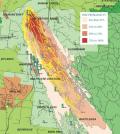Colin Simpson's Bushfire CRC PhD is investigating the dynamic interactions between a wildfire and the surrounding atmosphere. This video was recorded at the 2010 Annual Conference in Darwin.
Weather Predictions under Extreme conditions
At the start of the FireDST project, the remarkable skill improvements in numerical weather prediction in the previous decade had not yet delivered an operational forecast system that could help predict fire behaviour.
The fire weather research challenge was to push the current four km grid spacing limits of the Australian operational forecast system, called ACCESS (Australian Community Climate and Earth-System Simulator) to a finer gradation. The project team, led by the Bureau of Meteorology's Dr Jeff Kepert, also sought to analyse and verify the fine-scale wind structures that were important to fire behaviour. This involved building capacity within the Centre for Australian Weather and Climate Change Research to do very high-resolution (grid spacing of less than one km) historical forecasts of the meteorology of recent, significant fire weather events.
ACCESS has now been run at horizontal resolutions down to 400 metres and temporal resolution information up to every five minutes. It includes the vertical atmosphere at 3.6 kilometre resolution and 15 minute time steps. It is important to note that this research mode uses computer power more than 10 times faster than is currently used operationally. This magnified perspective reveals fine details of many small-scale, atmospheric structures that are likely to have an impact on fire spread and intensity. These include boundary-layer rolls, undular bores and solitary waves, small-scale vortices on wind changes and a broad spectrum of wind change types.
Most of these phenomena were verifiable in observations. Few of these features are well resolved in contemporary operational forecast models, and many were surprising to the researchers, forecasting and fire communities.
The meteorological information has been modified to produce a more realistic understanding of the local wind affecting the fire spread, using a simplified model that accounted for the effects of terrain and topography. The simplified model reveals the impact these interactions may have on a forest or building – information not previously available.
Two postgraduate studies reinforced this research. Mika Peace, of the University of Adelaide, focused her PhD study on the factors contributing to unexpected fire behaviour. Her simulation results suggest that the potential for extreme fire behaviour arises from interactions between the fire and the atmosphere. She completed three case studies around complex fire wether interactions in Western Australia and Kangaroo Island, South Australia.
The PhD work of Colin Simpson at the University of Canterbury looked at how weather affected bushfire spread in mountainous regions. He investigated atmospheric interactions with bushfire behaviour through the application of numerical weather prediction and fire behaviour coupled modelling.
Related News
Publications from this Project
Journal Article
Conference Paper
External References
This Bushfire CRC project is developing an advanced software program that will help fire managers fight bushfires faster and more effectively, while also identifying communities most at risk from fire. The research team explains the early stages of this research in this video.














